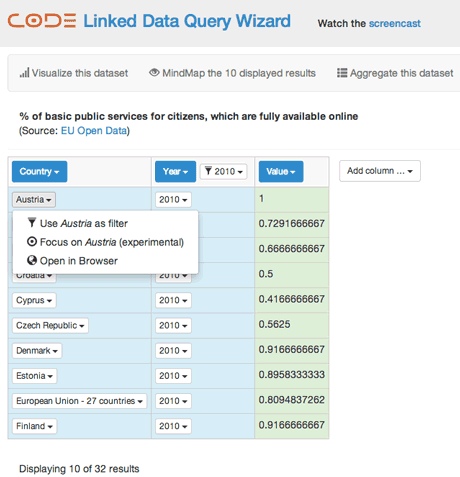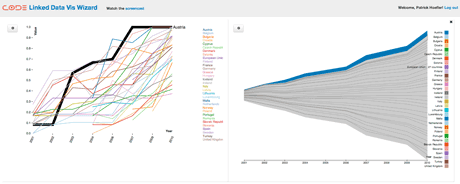by Patrick Hoefler and Belgin Mutlu
Although the concept of Linked Data has been increasing in popularity, easy-to-use interfaces to access and make sense of the actual data are still few and far between. The CODE project's Query Wizard and Vis Wizard aim to fill this gap.
The amount of Linked Data available on the Web is growing continually, due largely to an influx of new data from research and open government activities. However, it is still quite difficult to directly access this wealth of semantically enriched data without having in-depth knowledge of semantic technologies.
Therefore, one of the goals of the EU-funded CODE project has been to develop a web-based visual analytics platform that enables non-expert users to easily perform exploration and analysis tasks on Linked Data. CODE’s vision is to establish a toolchain for the extraction of knowledge encapsulated in scientific research papers along with its release as Linked Data [1]. A web-based visual analytics interface should empower the end user to analyse, integrate, and organize the data. The CODE Query Wizard and the CODE Vis Wizard fulfill this role.
When it comes to working with data, many people know how to use spreadsheet applications, such as Microsoft Excel. In comparison, very few people know SPARQL, the W3C standard language to query Linked Data. The CODE Query Wizard [2] provides a web-based interface that dramatically simplifies the process of displaying, accessing, filtering, exploring, and navigating the Linked Data that’s available through a SPARQL endpoint. The main innovation of the interface is that it turns the graph structure of Linked Data into tabular form and provides easy-to-use interaction possibilities by using metaphors and techniques that the end user is already familiar with.

The CODE Query Wizard offers two entry points: A user can either initiate a keyword search over a Linked Data repository, or select any of the already available datasets, represented as RDF Data Cubes. In both cases, the CODE Query Wizard presents a table containing the results. The user can then select columns of interest and set filters to narrow down the displayed data. Additionally, the user can explore the data by “focusing” on an entity, or can aggregate a dataset to obtain a summary of the data.
Once a user is happy with the selected data, it can be visualized using the CODE Vis Wizard [3]. This tool enables visual analysis of Linked Data, and supports the user by automating the visualization process. This means that after analyzing the structural and semantic characteristics of the provided Linked Data, the CODE Vis Wizard automatically suggests any of the 10 currently available visualizations that are suitable for the provided data. Furthermore, the Vis Wizard automatically maps the data on the available visual channels of the chosen visualization. If the user wishes to adjust the mapping, this can be achieved with a few simple clicks.

Usually more than one visualization is suitable for any given dataset. In this case, all visualizations can be displayed side by side. When certain parts of the data are selected in one of the visualizations, they are automatically highlighted in the others as well. This can provide quick insights into complicated data, taking advantage of the powerful human visual perception system.
The CODE Query Wizard and Vis Wizard are purely web-based systems. They currently support Virtuoso, OWLIM and Bigdata SPARQL endpoints, since these also provide integrated full-text search. However, since the prototypes have been designed to use Semantic Web standards, such as SPARQL, wherever possible, support for other suitable endpoints could be added at a later point with minimal effort.
Both prototypes have been developed within the CODE project at the Know-Center in Graz, Austria, with support by their project partners University of Passau, Mendeley (London) and MeisterLabs (Vienna). The project started in May 2012 and will finish in April 2014.
Links:
CODE project: http://code-research.eu/
CODE Query Wizard & Vis Wizard: http://code.know-center.tugraz.at/
References:
[1] C. Seifert et al.: “Crowdsourcing Fact Extraction from Scientific Literature”, in A. Holzinger & G. Pasi (Eds.), Human-Computer Interaction and Knowledge Discovery in Complex, Unstructured Big Data, Springer, 2013. dx.doi.org/10.1007/978-3-642-39146-0_15
[2] P. Hoefler et al.: “Linked Data Query Wizard: A Tabular Interface for the Semantic Web”, in P. Cimiano (Ed.), The Semantic Web: ESWC 2013 Satellite Events, Springer, 2013, dx.doi.org/10.1007/978-3-642-41242-4_19
[3] B. Mutlu et al.: “Suggesting Visualisations for Published Data”, in proc. of IVAPP 2014, SCITEPRESS, 2014.
Please contact:
Patrick Hoefler
Know-Center GmbH, Austria
E-mail:











